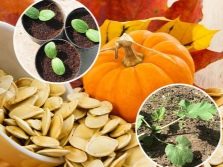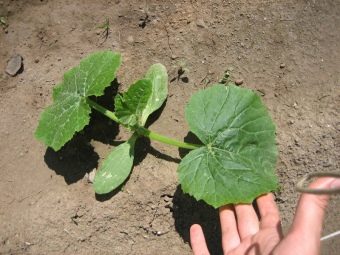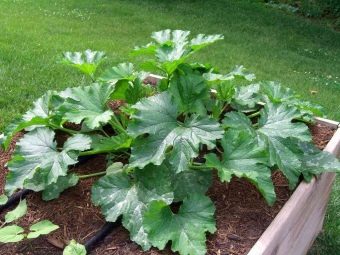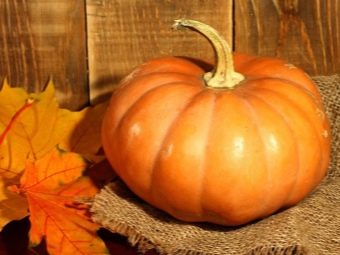How to distinguish the seedlings of squash from the pumpkin?

Pumpkin and zucchini are dietary vegetables.In fact, it is a storehouse of vitamins and microelements. Gourds gardeners love to grow in their gardens. The rules for planting such vegetables are simple, the yield is high, and care is simple. Novice gardeners will probably come in handy knowledge of how to distinguish the seedlings of zucchini from the pumpkin.
Features of cultures
Pumpkin refers to annual plants. She has a powerful root system that goes three meters deep into the soil. Pumpkin stems are branched, creeping and reach up to seven meters long. The plant is pollinated by insects. Zucchini - a plant annual, early, gives a lot of fruit. Its roots are powerful, grow deep into the soil. On a thick stalk large leaves are located.
Pumpkin seeds can be stored for up to 10 years, seeds are suitable for sowing after two, three years of storage, and female flowers are formed with good fruiting, disease resistance. Freshly harvested seeds are not suitable for sowing. They give plants with powerful stems, male flowers that are prone to poor harvest.
When sowing seedlings, you need to use separate containers, attach a label with the name of the crop, variety and fix it with tape to better preserve the inscription. To plant seedlings in the ground is at a decent distance. For squash the soil is better not to overdry, they can lose the ovary, no longer bear fruit. For this culture, drought is destructive, the pumpkin will survive these difficulties. Squash plants suffer from fungal diseases, powdery mildew. Pumpkin plant disease is not affected. Kabachkovye bushes suitable place for planting in the compost heap.
Rules for planting melons
Pre-seed germinated, incubated in a weak solution of potassium permanganate. This is done in late March or early April. The solution is prepared at the rate of 2 grams of manganic acid potassium per 250 ml of water. In the solution of the seeds stand for 15 minutes, rinsed with running water, at a temperature of about plus 25 degrees spread between layers of clean, damp cloth or gauze. All this design is constantly moisturize when dried. After sprouting, seeds are planted in one or two cups with a mixture of earth, humus, and mineral fertilizers.
To transfer to the greenhouse cups with sowing tightly placed in boxes, poured with water, covered with foil. It is advisable to keep the temperature in the greenhouse +25 degrees. When pecking shoots, after about a week the temperature is reduced to +17 degrees. Water the plants need heated water so that they do not die. It is recommended to feed two times with fertilizer. After twenty, twenty-five days, a third sheet will appear. Then they make a landing in open ground (beginning of May), while providing moderate watering. Seedlings do not need to plant densely so that they do not interfere with each other. Then the harvest will not be meager.
In order for the pumpkin relatives to “intermarry” with the open ground, it is necessary to harden the plants two weeks before planting. Enough during the day to make the seedlings on the street, and at night to put in the greenhouse.
Are the squash seeds helpful?
The composition of squash seeds include santonin - a substance that eliminates worms. Seeds are rich in minerals and vitamins. Seeds are natural antioxidants. With a strict diet for a variety of diet using seeds zucchini. For the prevention and treatment of certain diseases, doctors recommend using dried seeds.
In diabetes, dried, ground seeds are mixed with honey. Gruel diluted with warm water, drink in small sips in the morning. New portion is prepared every day. Ratio: two tablespoons of seed powder take half a tablespoon of honey and diluted in 100 ml of water.
To combat worms, seeds are not dried. Raw, peeled seeds (50 grams) plus 200 ml of water are brought to a boil, steamed for 15 minutes, infused for two hours in a warm place, filtered, take half a glass of pre-heated infusion between breaks in the meal.Squash seeds are used for nervous diseases, high tension, fear, reduced tone, and weak immunity. Indisputable use of zucchini seeds for men. All uniqueness in the chemical composition of the grains. Zinc, present in seeds, combats inflammatory processes, improves reproductive function. With regular correct use it is possible to cure infertility.
A man needs to eat up to 100 g of sprouted seeds with sprouts every morning. Result: testosterone production is accelerated, semen quality improves, potency, sexual desire returns. It is recommended to reduce physical exertion, take an additional vitamin-mineral complex. If the seeds of zucchini are not properly taken and not pre-processed, they can harm the body.. Seeds do not satisfy hunger, it is better not to use them as a snack, since they can cause strong thirst.
You can not use the seeds with salt, as an additional load on the kidneys.
Are pumpkin seeds helpful?
Pumpkin - a storehouse of vitamins and nutrients. It consists of: amino acids, pectin, saturated and unsaturated fatty acids, vitamins, minerals, dietary fiber. This is not very different from the zucchini. Seeds are most valued in the pumpkin. Eating them relieves constipation, reduces the content of bad cholesterol in the blood, helps with depression, stress, heals wounds, improves metabolism, normalizes blood pressure, acts as a diuretic, laxative, fights parasites. It is recommended to include pumpkin seeds in the diet for children, adolescents, the elderly, pregnant women, and athletes. To avoid swaying when traveling in transport, you can chew pumpkin seeds.
Be careful of using seeds is for people prone to allergies. Not recommended for high acidity, obesity, in diseases of the gastrointestinal tract. Pumpkin seeds are very high in calories, the daily rate should be no more than 100 grams per day. If the product is abused, stomach ulcers may worsen. For men, pumpkin seeds are useful for the genitourinary system, prevent the development of osteoporosis, prevent the deposition of salts in the body and the formation of stones. Arachidonic acid pumpkin seeds restores memory, helps in strengthening the blood vessels. And pumpkin pulp has a softening effect on the skin.
How to distinguish?
The seedling is ready for planting, it is already crowded in pots, but sometimes it is impossible to determine which plant belongs to which crop. An experienced gardener is not a problem to distinguish zucchini seedlings from cabbage, pepper from tomatoes, but squash and pumpkin are a dilemma even for a professional. The fact is that the zucchini and the pumpkin are the "related" tandem of the pumpkin family. They are so similar that their young shoots are very easy to confuse. Family ties hinder them, so these cultures should not be planted nearby in order to avoid over-pollination. The result may be tasteless pumpkin fruit with a rough, thick skinned. A zucchini can acquire odor and color that are not peculiar to it.
If you are careful, you can set several distinctive properties of the zucchini and pumpkin seedlings.
By seed
Squash is longer than pumpkin. Have an oval, elongated shape. Pumpkin rounded, have a sharp little nose. Zucchini different whiteness seeds with a slight touch. Pumpkin seeds is not easy to crush with your fingers into two slices. The seedlings are large and grows faster. If you bathe the seeds of both plants in water, then the zucchini will remain light and the pumpkin will turn yellow.
Shoots
Looking at the young shoots, you can find differences. Zucchini leaflets long, narrow. The first sheet is carved, light green. Pumpkin plant - dense, strong, not stretched, the leaves are powerful, tough, rough, green.
Over the leaves
The cotyledon leaves of the zucchini are longer, thinner on the lumen.In pumpkin, they are dense, round. Some squash varieties have leaves with whitish, yellow spots.
By seedlings
Hard, powerful, dark pumpkin seedlings are not prone to pulling with a squat, thick stem. Differs from zucchini with cotyledon leaves, thin to the light, dissected with a sharp corner of the leaf, light green in color. Simply put, the first leaves are exactly the shape of a seed. Squash seedlings more light-requiring, without light pulled out, brightens.
According to an adult plant
Zucchini bushes, pumpkin spreads its long lashes, which are trying to cling to the ground, to put new roots. Externally, the flowers of both plants are similar - white, yellow, in the form of a funnel. The insignificant differences consist in the fact that the pumpkin is a more powerful plant, it has large flowers, which are located along the main stem. Kabak flowers bloom from the middle of the bush.
According to the fruits
Pumpkin orange, round, sweet, has a distinctive flavor. Pumpkin fruits ripen at the end of the summer. The elongated, elongated, oval shape of the zucchini is of yellow, green, white color, sometimes with stripes. The taste is bland. Can bear fruit before the first frost.
In order not to experience difficulties in determining the seedlings, it is necessary to dry the collected seeds of each plant, warm it in the open sun, fold it into separate paper bags for storage, write the collection time, the name of the crop.
Look at the seedlings of zucchini and pumpkins, see the video below.










































